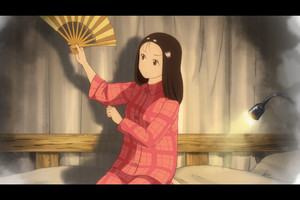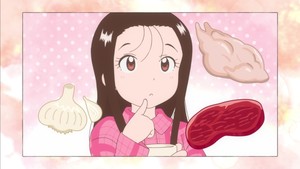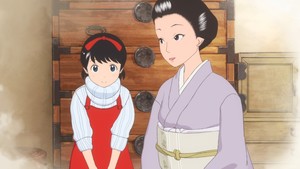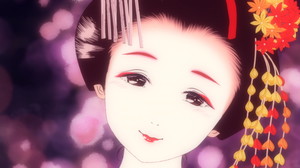The Spring 2021 Preview Guide
Kiyo in Kyoto: From the Maiko House
by The Anime News Network Editorial Team,
How would you rate episode 1 of
Kiyo in Kyoto: From the Maiko House ?
Community score: 3.7
What is this?

In Kyoto's "hanamachi" geisha quarter, after geisha finish their work late at night, they spend the night resting at a lodge to prepare for the next day. The story centers on Kiyo, an Aomori native who works as a cook in a geisha lodge in Kyoto after finishing junior high school and leaving home. She also has a friend named Sumire who is a maiko, or apprentice geisha.
Kiyo in Kyoto: From the Maiko House is based on Aiko Koyama's manga and streams on Crunchyroll at 7:30 p.m. EST on Wednesdays.
How was the first episode?
 Caitlin Moore
Caitlin Moore
Rating:
Geisha have long been a source of fascination for people all over the world, but much of that fascination has become muddied with misconceptions and stereotypes about what exactly a geisha does. In the US in particular, tawdry “geisha” Halloween costumes and Arthur Golden's truly terrible novel Memoirs of a Geisha have built up an image of geisha as high-class sex workers, when they are nothing of the sort.
Kiyo in Kyoto works counter to this image, following Kiyo, a live-in cook for a geisha house, and her best friend Sumire, a geisha-in-training, also known as a maiko, who has the potential to be one of the very best. While Sumire practices at all hours of the day, even when the other maiko are resting and taking well-deserved breaks, Kiyo creates delicious and nutritionally balanced meals for the hard-working residents. It's cute and sweet and chill.
It is also, to be honest, a little boring. The series is produced for NHK world, which means it has to have an educational bent. Most of the story is told through gentle narration explaining who the people are and what role they play in the world of geisha and maiko, such as the kitsuke, or dresser, who helps the women into their elaborate, heavy kimono and is one of the few men allowed into the mostly-female world. There seems to be the seeds for a story about high expectations and burn-out, with Sumire working herself to the point that she's unhealthily losing weight, but it remains to be seen whether or not those seeds are going to pay off.
A stronger focus on the visuals would have done a lot to bolster Kiyo in Kyoto, but as is, it's barely animated. While the art style is cute, it doesn't make up for how static everything is. Very little move other than characters' mouths, and when they do, it's through CG models. Some lovingly animated food porn, or careful attention to the maikos' movements as they practice dance or music, could have really brought life in the maiko house to, well, life.
It's a nice little show, and one worth checking out if you're curious about Kyoto and geisha. It's pleasant and educational and for a lot of people, that's enough of a draw. It's just a little disappointing, because with a bit more oomph, it could have found a decent audience, which I doubt will happen as it is.
 James Beckett
James BeckettRating:
I didn't know that Kiyo in Kyoto was a J.C. Staff production when I started watching it, but it didn't take me long to guess. Like the two High-Score Girl series that the studio produced, Kiyo in Kyoto's use of CG animation is notable for being pretty okay, so far as the anime industry standards are concerned. It's no Beastars or Land of the Lustrous, but J.C. Staff has done a good job of creating 3D anime that still feel like anime, which manage to use effective character animation and colorful background work to give their shows a more “traditional” look. Kiyo in Kyoto doesn't quite have the charm and energy that High-Score Girl possessed, but that's not the vibe the show is going for, anyways. Despite some occasionally limp direction and storyboarding, I was able to get through long stretches of Kiyo in Kyoto without even remembering that I was watching a largely computer-generated anime, and I think that's pretty cool.
Kiyo in Kyoto is one of those part-iyashikei, part-edutainment anime that takes the hyper-low-stakes formula of a traditional slice of life anime and uses it as the backdrop for a series of informative vignettes. In this show's case, we have the twin story of our two heroines: Kiyo is a girl from Aomori that has moved to the big city of Kyoto to work as a cook in one of the city's historical geisha lodges, while her best friend Sumire has dedicated her life to serving as a maiko (an apprentice geisha). So what we basically have is a story that has a wealth of cool factoids about the city and the traditional practices of the geisha when it focuses on Sumire, while Kiyo's half of the narrative shows off all sorts of delectable Japanese cuisine.
The edutainment half of the premise is something I can totally get behind, but it's the iyashikei part that I struggle more with. My ADHD-addled brain generally needs some sort of conflict or rhythm of plot to get its hooks into a story, and I've traditionally struggled to get into the hangout comedies where 90 percent of the focus is on the hanging out, while any fleeting moments of humor or absurdity are mostly incidental. I had to keep pausing the episode to check how much time was passing, because I was convinced that this half-hour premiere was roughly ninety minutes long.
In short, this is just not the kind of show I can fully engage with for more than a few minutes at a time without getting incredibly distracted and antsy. I'm still happy to give Kiyo in Kyoto a positive rating, though, because I recognize that it does what it sets out to do fairly well, and there is some fun to be had in learning along with Kiyo and Sumire. In-depth looks at specific parts of Japanese culture are cool. Delicious-looking food is also cool. Any show that lets viewers indulge in both of those things is doing something right.
 Rebecca Silverman
Rebecca Silverman
Rating:
Kiyo in Kyoto: From the Maiko House is sweet, cute, and harmless. I was also bored out of my skull. In large part I think that's due to the fact that this is essentially three shorts strung together to make one full-length episode, and given the dearth of conflict, that makes this a story that would have been more palatable in bite-size pieces. It certainly doesn't help that structurally, this even feels like three cobbled-together short episodes; each little segment ends with a chat between series leads Kiyo and Sumire about food, which absolutely feels like the type of extra padding used to round out an episode before the next week. Having this happen after each episode just seems a bit awkward.
The plot, such as it is, revolves around Kiyo and Sumire, two friends from Aomori who both came to Kyoto to learn to be maiko, apprentice geisha. Sumire excelled at the art, but Kiyo not so much, and now an unspecified number of years later, Sumire's about ready to make her debut while Kiyo has become the Maiko House (dorm) cook. Plenty of not-so-veiled remarks from the adults make it clear that they feel that Kiyo should have just gone back to Aomori when she failed to make it as a maiko or an otokoshi (dresser), and Sumire, when she has the time to think about it, worries that her friend will be hurt by her success. But Kiyo seems oblivious to it all, gleefully shopping and cooking.
That's what I mean by this episode lacking any conflict. It's fine for a five-minute episode to have thin plot and no action or conflict, but for twenty-five minutes to work, it has to offer me more than cute and mild worries over hurt feelings. This isn't to say that there's nothing to recommend Kiyo in Kyoto: From the Maiko House, however. There are plenty of little facts sprinkled throughout, such as that a full ensemble weighs up to 20 kg (44 pounds; for comparison, that's about how much a woman's dress and undergarments weighed in the 1850s before the hoopskirt), which is why they need otokoshi, and the observable information that once a maiko puts her hair up, she just leaves it there for long periods of time. I also found Kiyo and Sumire's “daily dish” about pudding to be interesting, if only because old-fashioned hot puddings – bread pudding, rice pudding, Indian pudding – are one of my specialties.
There is potential for a more serious plotline, assuming that subsequent episodes build on each other. Several people mention that Sumire's drive to be perfect has her skipping meals and losing weight, which is dangerous in a performance art setting; we actually see her skip three meals in a row in the third segment of this episode. That she's not actively trying to lose weight and instead just doesn't see eating as a good use of her valuable time could be developed into something with more tension, especially since Kiyo is the cook. But the smooth use of CG and beautiful kimono aren't enough to make me want to go any farther with this show. I love learning as much as the next academic, but I'd like my edutainment to have a better balance of elements than this has so far.
 Nicholas Dupree
Nicholas Dupree
Rating:
Hey kids, are you ready for some fun? Well how about fun, while LEARNING? Because it's time for another edutainment anime here to teach you all about...well technically about the intricacies of apprenticing as a future Geisha, but mainly about food. A lot of food, actually, so be warned not to watch this series on an empty stomach.
As a piece of entertainment, Kiyo in Kyoto is perfectly fluffy and wholesome. The setup of Kiyo, a failed Maiko who stays on at the boarding house as a cook to support her best friend's continuing apprenticeship, could make for something rife with interpersonal drama, but this show has absolutely no interest in it. Both Sumire and Kiyo seem totally happy and fulfilled with their roles and their friendship, and the softspoken enthusiasm Kiyo expresses towards cooking is as far as you can get from conflict. The result is a very docile series of slice-of-life vignettes interspersed with the characters discussing the various dishes they made directly to the audience. It's those moments in particular that make you feel like you're watching a PBS Kids program, and while not terrible, it sure does drag if learning basic trivia about pudding doesn't garner your interest.
The animation is also decidedly minimal. The show is primarily populated with CG character models, who only ever move as much as necessary in any given shot. The rigs themselves are actually pretty well integrated into the environments, with the soft edges blurring just enough that they don't feel awkward. I imagine for the target demographic of kids this won't stick out at all, but sharper-eyed viewers may feel a little uncanny at times. The interstitial segments are animated traditionally, but also don't move a whole lot, and in general the atmosphere of the premiere is carried by the voice actresses and music more than any animation or direction.
Overall this isn't a bad series, and if you want something low impact to get you in the mood for dinner, it might be worth a look. But I personally found my attention wandering during this premiere, and combined with the monthly episode release I'm confident I won't be returning to the Maiko House anytime soon.
 Lynzee Loveridge
Lynzee Loveridge
Rating:
I'm giving Kiyo in Kyoto the good ol' standard "3" because while it lacks any real appeal for me personally, it is an entirely serviceable promotional tool for Kyoto tourism and consistently looks way nicer than was required. We get these local tourism anime every once in a while with varying levels of success. Some of them, like Yatogame-chan Kansatsu Nikki, are overt, while others more subtle, like Sarazanmai. Kiyo in Kyoto falls in the "overt" category, honing in on key elements that tourists immediately associate with Kyoto: geisha (in this case, maiko), the cozy quaintness of traditional Japan, and local food.
The show's three-segment structure means it feels more like a travel info program than a proper narrative. There are characters, of course, and they have goals like becoming the top maiko or getting a great deal on potatoes. There's a little hint of emotional underpinnings, like when Sumire announces her success as a maiko to Kiyo who works at the maiko house as a cook; it is implied that at one point Kiyo was also training to be a maiko but dropped out. Nonetheless, she's a very supportive friend, so who knows if there's any real depth there.
The animation itself is very nice. It looks like the team at J.C.Staff utilized a cell shading technique on 3D models, but it isn't glaring. In fact, I'd call it one of the more successful attempts to come out of anime recently. If this lessens the load on the animators at all, I'd call it a win. It lacks many of the pitfalls typically associated with 3D animation work and is otherwise seamlessly blended with the show's stunning backgrounds. Now, not all of the animation work is done with this technique. The middle segment about food goes back to a more simplistic, talking-head style.
I'd file Kiyo in Kyoto under "relaxing," which isn't something I look to anime to fulfill (that slot is taken by nature documentaries) but I know plenty of folks do enjoy this specific genre. The show looks too nice not to recommend to that specific set of fans.
discuss this in the forum (370 posts) |
this article has been modified since it was originally posted; see change history
back to The Spring 2021 Preview Guide
Season Preview Guide homepage / archives